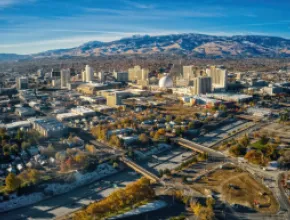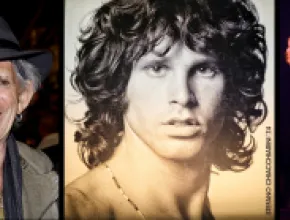As in previous years of our annual Meetings Today Las Vegas state-of-the-industry report, Las Vegas once again is dominating the North American tradeshow industry. Hosting 57 of the continent’s largest shows last year, including the 50th anniversary of the Consumer Technology Association’s (CTA) blockbuster CES (Consumer Electronics Show), the destination topped the Trade Show News Network’s “Top 250 U.S. Trade Show List” for the 23rd year in a row.
For comparison, Orlando was second with 25 shows, followed by Chicago with 20 and New York with 19.
Conventions and meetings in 2016 drew a record 6.3 million participants, up 7.1 percent, contributing to a third consecutive groundbreaking year for Southern Nevada tourism, with 42.9 million visitors.
Las Vegas is making strides on the global level, too. Just before celebrating Global Meetings Industry Day (GMID) in April, the city hosted the 48th General Assembly of the World Trade Centers Association (WTCA). Drawing representatives from 90 WTCs representing 33 countries around the globe, the event opened with the official signing of a Memorandum of Understanding (MOU) between the WTC Las Vegas and WTC Santiago, Chile.
As the only North American convention campus with a WTC designation—created in 2010 between the Las Vegas Convention and Visitors Authority (LVCVA) and CTA—Las Vegas already has at least 11 such MOUs in place, including with WTCs in Brussels, Mexico City, Beijing, Istanbul and Dulles Airport, which services the Washington, D.C. area.
Commemorating the moment and global events like GMID, participants posed for a group photo holding “Vegas Means Business” cards in a variety of languages.
Fasten your seat belt. With the jet ready for takeoff, Vegas is aiming for the world.
Market Muscle
Hosting 6.3 million attendees at nearly 22,000 meetings last year was “an all-time high for convention visitation,” said Chris Meyer, LVCVA vice president of global business sales, crediting in large part “continued strength among large tradeshows and a notable increase in small- to medium-size conventions.”
Anticipating “steady growth in visitation” ahead, he affirmed, as always, that Vegas “is not a destination that rests on its laurels.”
As countless conventioneers know, the services, experiences and hospitality here are second-to-none, helping to create the attendance-boosting “Las Vegas effect.” The first step in this formula, of course, is promoting and perpetuating excitement in the Las Vegas brand.
In his just-published book The Strip: Las Vegas and the Architecture of the American Dream, Stefan Al, associate professor of urban design at the University of Pennsylvania, asserts that “as outrageous as the Strip’s excesses may seem, it has always been the ultimate manifestation of a quintessentially American practice: marketing.”
Which is where the LVCVA comes in. Founded in 1955 as the Clark County Fair and Recreation Board to market the destination, the organization has a most persuasive story to tell.
“If you can dream it, Las Vegas, a 24-hour destination that never stops reinventing itself, is likely to have it,” Meyer said.
The Vegas advantage starts with access, including hundreds of daily inbound and outbound flights and a wide variety of nonstop options at McCarran International Airport. Then, it’s a short drive into a compact universe of options encompassing nearly 150,000 hotel rooms, 11 million-plus square feet of meeting space, world-class entertainment, celebrity chefs, shopping, outdoor adventures and more.
“Whether for an intimate meeting of 10 professionals or a massive tradeshow with 170,000 attendees, it’s the world’s best group value proposition,” Meyer said.
Heeding the hard lessons of the past, persistent industry competition and the voice of the customer, the destination takes none of this for granted.
“Our industry and resort partners are constantly evolving to meet the needs of our visitors and deliver on the business experience that is synonymous with our city’s reputation,” Meyer said. “With our tradeshow customers expressing a need for growth, evolution and innovation at the Las Vegas Convention Center in recent years, our destination has taken aggressive action to accommodate those interests.”
PageBreak
Continuing to deliver on its brand promise of “unmatched” hospitality is another strategic imperative.
“This brings our visitors back time and again,” Meyer said. “Many meeting planners are now investing in the full lifecycle of the convention attendee, engaging with them from the time they register to the time they leave.”
With online gaming among the trends reshaping the Vegas offering (see “Trend Watch,” page 10), Meyer sees the Las Vegas Convention Center District (LVCCD) expansion as the most significant development in recent years.
“The decision to move forward with the LVCCD demonstrated a great deal of community support and forward-thinking leadership in recognizing the far-reaching impact this project has on the future of Southern Nevada’s economy,” he said. “More than just a project to benefit the convention center, the LVCCD truly represents an investment for the entire industry and our destination. As we grow our shows, we increase the number of visitors, which ultimately benefits the entire city through increased room occupancy, eateries, show tickets and more.”
Miked Up
Commanding most of the Strip between them, MGM Resorts International and Caesars Entertainment continue to spearhead transformation and evolution in the Las Vegas meetings market.
“Vegas was still in a down cycle when I arrived, slowly coming off the recession,” said MGM’s Senior Vice President and Chief Sales Officer Michael Dominguez, who joined the company in 2012. “Since stabilized, the market has gained visibility as the go-to convention city, alongside parallel development of its identity as a place for world-class entertainment and sports.”
Looking at a fourth consecutive year of record revenue, cash flow and EBITDA growth, MGM continues to execute on high-percentage convention contracting and room night booking.
“Vegas will always reinvent itself,” Dominguez said. “Seventy percent of our revenue now comes from non-gaming, as we continue to invest in world-class entertainment and other products. Our goal, ultimately, is about bettering the industry, along with the communities and people we serve.”
For Michael Massari, Caesars’ chief sales officer, “a new normal” followed the downturn.
“The world changed, and we all had to figure out how to be smarter and more efficient in business,” he said.
For Caesars, Massari’s bold reorganization and streamlining of the meetings team, which included putting the sales force closer to customers and creating a single point of contact for the brand’s national network of group properties, continues to yield major dividends.
Predicting the future, even short-term, is a challenge.
“As technology keeps changing how people participate in meetings, it’s hard to say,” Massari noted. “One thing is for sure, though. The history books will remember this era as a true inflection point.”
As other major players, including Wynn Resorts, Las Vegas Sands, Treasure Island owner Phil Ruffin, and Penn National Gaming (owners of Tropicana Las Vegas, a DoubleTree by Hilton and the M Resort Spa Casino in Henderson) make their own strides, two other enterprises on the move are Station Casinos and developer-owner brothers Derek and Greg Stevens, making big moves Downtown.







